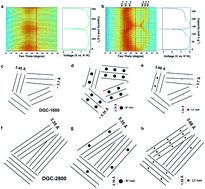Potassium-ion storage behavior of microstructure-engineered hard carbons†
Abstract
The staging of potassium-ion intercalation reactions with graphite-like carbon materials has been previously chronicled; however, the potassium-ion storage behavior of disordered graphitic carbons (DGCs) has not been elucidated owing to their complex microstructures and the lack of systematic studies. In this study, microstructure-engineered DGCs were prepared using natural polymers by simple pyrolysis, followed by high-temperature annealing from 1200 °C to 2800 °C, and their potassium-ion storage properties were investigated and compared with their lithium-ion storage characteristics. In contrast to the lithium-ion intercalation reactions, which are dependent on local graphitic ordering, the stage I potassium-ion intercalation reaction was found to occur in highly disordered graphitic structures with a few nanometer-sized graphitic domains and an expanded d-spacing of >3.5 Å. In addition, the potassium-ion intercalation reactions with the highly expanded graphitic lattices were considerably faster and more stable compared to those with the highly developed disordered graphitic structures. These results suggest that hard carbons with a loosely packed disordered graphitic structure can be employed as effective high-performance anode materials for potassium-ion batteries.



 Please wait while we load your content...
Please wait while we load your content...